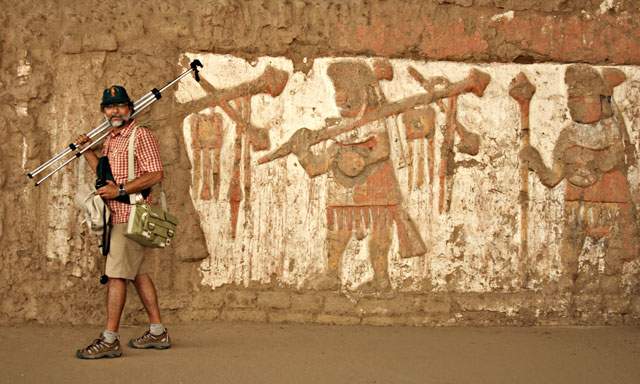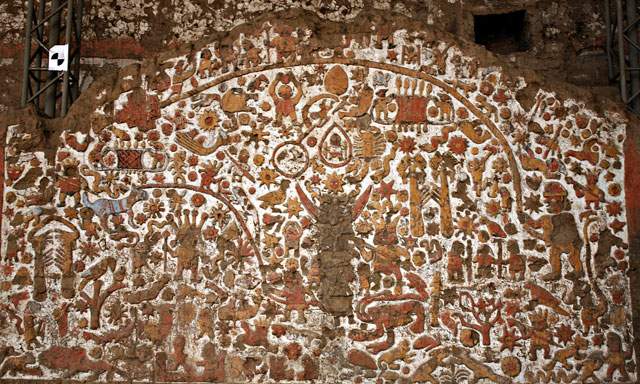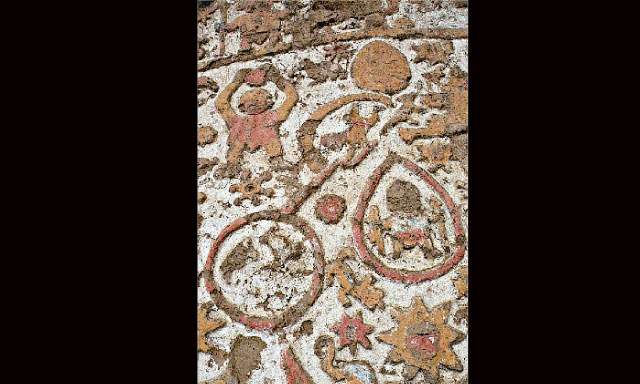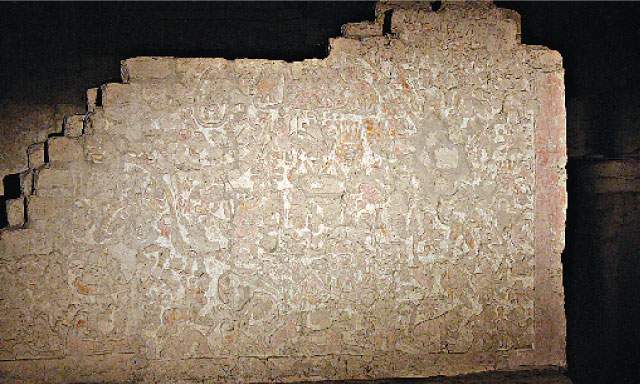It looks like you're using an Ad Blocker.
Please white-list or disable AboveTopSecret.com in your ad-blocking tool.
Thank you.
Some features of ATS will be disabled while you continue to use an ad-blocker.
8
share:

The book will be presented tomorrow and promise to be something really good, as I read, it includes an english translation and a CD. That's like chocolate for ATSers, I must say.

The astronomical system of the Moche culture seeks to be revealed through the study of four walls of great iconographic content: two discovered at Huaca de la Luna and two in the Huaca El Brujo. The findings are contained in the book Cosmos Moche, which speaks of the great knowledge they had about the stars and the elements.

Translation :
The work includes two investigations of the mysterious murals Huaca de la Luna and Huaca El Brujo. The edition is bilingual and has been edited with photographs, illustrations and infographics.
Dr. Walter Alva Alva will be responsible for the launch of Cosmos Moche, on Wednesday September 19 at 6 pm in the strata of Bethlehem House, home of Andrew Castle Museum.
The work includes two research revealing the complex iconography that decorates four walls discovered at Huaca El Brujo and Huaca de la Luna in La Libertad region. Since the first discovery, made in July 1990, the walls are still one of the greatest enigmas of ancient Peru.
The first investigation is the work of anthropologist Dr. Rodolfo Sanchez Carafe. The second by archaeologists and Camilo Salazar Lydia Homes Dolorier. The work has been edited by Roberto Ochoa Berreteaga, a journalist specializing in the dissemination and identification of new tourist destinations in Peru.
Dr. Rodolfo Sanchez examines the structures and symbolic contents of the four walls "complex" found at Huaca Cao Viejo and the Temple of the Moon, and the symbols are astronomical and terrestrial (characters, scenes, flora and fauna) are elements build a complex worldview centered Andean duality and seasonal changes related to astronomical markers. He further argues that the friezes of the four walls are intimately linked as equinox representations of heaven and the stars that illustrate the walls were located in the corresponding astronomical position.
Meanwhile, Lydia Salazar and Camilo Casas Dolorier pictorial chaos seen in the Wall Complex Topic Huaca de la Luna a social cosmos propitiatory rites linked to subsistence for land and sea-fights through fishing and rituals-that allow the choice of heroes victors begin their own journey to the sacred. We further propose that an iconographic wall may represent a bio-indicator species or marine Niño.
As we know, these walls are part of the main attractions in Trujillo called Circuit Moche iconography is complex and that causes more questions with tourists: why are there so many stars? What mysterious hieroglyphs hidden message of this wonderful mural? Do your pictograms are proof of the existence of secret writing Moche elite? Is the cryptography to determine a special date in the calendar moche unknown?
Researchers try to answer these questions based on multidisciplinary research foundations including anthropological, archaeological, biological and arqueastronomía. The book has been published in paper coated with dozens of photographs, illustrations and infographics. Includes an English translation respecting the location of the illustrations and bring a CD on Moche worldview edited in the Museum of Huaca de la Luna.
The ceremony will include explanations of the authors, upon presentation by Dr. Walter Alva Alva and Dr. Guido del Castillo, Andres founding president of the Castle Museum, the collection sponsor Enigmas of Ancient Peru.
www.larepublica.pe...
About those walls :
Another translation :


www.larepublica.pe...
Another translation :
If this wall speak solve one of the great enigmas of the Moche culture. Archaeologists christened unattractive name of "the wall of the complex issue", but the truth is that there is a single wall, are four: two in the Huaca El Brujo, in Magdalena de Cao, and two in the Huaca de la Luna in Trujillo.
In both cases each pair of walls are at right angles and complex iconography has as central image of the waning moon with a star in the middle, similar to the flags of Islamic countries. In both cases the images look well preserved, but beneath the moon there is a trace of wall eroded by the "chisgueteo" a liquid that archaeologists identified, not without horror, as human blood. In both cases the walls were part of a dark room on the corner of a huge ceremonial plaza decorated with scenes of warriors that carry a war chest built by a long line of naked prisoners willing to sacrifice ritual.
The first of the walls was found on 28 July 1990. While the country celebrated Independence Day and was attentive to the inauguration of Alberto Fujimori in Congress, in the Magdalena de Cao recalled banker William "Pancho" Wiese de Osma and archaeologist Franco Jordan Regulus looked stunned a corner of the first wall emerging among the rubble left by looters. The finding gave rise to the now famous archaeological complex of El Brujo, whose main attraction to the mummy of the Lady of Cao.
This discovery would have been enough to revolutionize knowledge of the Moche culture, but six years later, in 1996, a team of archaeologists led by Santiago Uceda and Ricardo Morales unearthed in the Huaca de la Luna the other two walls almost identical and much better preserved than those of El Brujo.
The walls are the main attractions in Trujillo called Circuit Moche iconography is complex and that causes more questions with tourists: why are there so many stars? What mysterious hieroglyphs hidden message of this mural? Do your pictograms are proof of the existence of secret writing Moche elite? Is cryptography to determine a special date in the calendar Moche unknown?
It's been over twenty years since its discovery and the walls with the "complex issue" of Huaca de la Luna and Huaca El Brujo are still one of the greatest enigmas of ancient Peru.
Beyond the reports published in media Peruvian and foreign, to date the enigmatic "Wall complex issue" only deserved the pioneering publication of the book entitled The Witch, The Wizarding World Mochica Religious and Ceremonial Calendar, written by Franco Regulus Jordan and John Vilela Puelles. The authors propose the existence of a ceremonial calendar based on an analysis of the rites and ceremonies contained in the narrative structure of the wall. And added: "This research is only one step in understanding the complex structure of the calendar system ... we are confident that our proposal will be heavily debated, but the purpose of this research is to achieve testable information or enriching other approaches on".
The discussion is still standing and now justifies the publication of the book Cosmos Moche, as the first in the collection Enigmas of Ancient Peru. "This book is a contribution to the scientific debate on a stage in our history that has only managed to recover thanks to the work of archaeologists says Dr. Guido del Castillo, collection manager. The Moche were a civilization that flourished in what is now Peru thousand years before the Inca heyday. The research provides new insights to understand this great civilization. "
The work consists of two scientific research illustrated with photographs, drawings and computer graphics. The first by the anthropologist Dr. Rodolfo Sanchez Carafe. The second by archaeologists and Camilo Salazar Lydia Homes Dolorier.
Rodolfo Sanchez examines the structures and symbolic contents of the four walls "complex" found at Huaca Cao Viejo and the Temple of the Moon, and the symbols are astronomical and terrestrial (characters, scenes, flora and fauna) are elements that build a centered worldview Andean duality and seasonal changes related to astronomical markers. He further argues that the friezes of the four walls are intimately linked as equinox representations of heaven and the stars that illustrate the walls were located in the corresponding astronomical position.
Meanwhile, Lydia Salazar and Camilo Casas Dolorier pictorial chaos seen in the Wall Complex Topic Huaca de la Luna a social cosmos propitiatory rites linked to subsistence for land and sea-fights through rituals and fisheries- that allow the choice of heroes victors. We further propose that an iconographic wall may represent a species or marine bioindicator of El Niño.


www.larepublica.pe...
edit on 18-9-2012 by Trueman because: (no reason given)
edit on
18-9-2012 by Trueman because: (no reason given)
edit on 18-9-2012 by Trueman because: (no reason given)
reply to post by Trueman
Great find. i am interested with what the contents say. Please update ASAP, when new information is presented.
Great find. i am interested with what the contents say. Please update ASAP, when new information is presented.
new topics
-
Ditching physical money
History: 1 hours ago -
One Flame Throwing Robot Dog for Christmas Please!
Weaponry: 1 hours ago -
Don't take advantage of people just because it seems easy it will backfire
Rant: 1 hours ago -
VirginOfGrand says hello
Introductions: 2 hours ago -
Should Biden Replace Harris With AOC On the 2024 Democrat Ticket?
2024 Elections: 3 hours ago -
University student disciplined after saying veganism is wrong and gender fluidity is stupid
Education and Media: 5 hours ago -
Geddy Lee in Conversation with Alex Lifeson - My Effin’ Life
People: 6 hours ago -
God lived as a Devil Dog.
Short Stories: 7 hours ago -
Police clash with St George’s Day protesters at central London rally
Social Issues and Civil Unrest: 8 hours ago -
TLDR post about ATS and why I love it and hope we all stay together somewhere
General Chit Chat: 9 hours ago
top topics
-
Hate makes for strange bedfellows
US Political Madness: 11 hours ago, 18 flags -
Who guards the guards
US Political Madness: 14 hours ago, 13 flags -
University student disciplined after saying veganism is wrong and gender fluidity is stupid
Education and Media: 5 hours ago, 10 flags -
Police clash with St George’s Day protesters at central London rally
Social Issues and Civil Unrest: 8 hours ago, 8 flags -
TLDR post about ATS and why I love it and hope we all stay together somewhere
General Chit Chat: 9 hours ago, 7 flags -
Should Biden Replace Harris With AOC On the 2024 Democrat Ticket?
2024 Elections: 3 hours ago, 4 flags -
Has Tesla manipulated data logs to cover up auto pilot crash?
Automotive Discussion: 16 hours ago, 3 flags -
One Flame Throwing Robot Dog for Christmas Please!
Weaponry: 1 hours ago, 2 flags -
Don't take advantage of people just because it seems easy it will backfire
Rant: 1 hours ago, 2 flags -
Geddy Lee in Conversation with Alex Lifeson - My Effin’ Life
People: 6 hours ago, 2 flags
8
